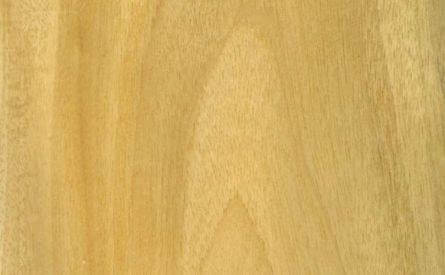Primavera
Palo Blanco / Roseodendron donnell-smithii

Local Names
Cortez Blanco, Guayape, San Juan Guayapeño, Duranga
Distribution & Tree
Often dubbed white mahogany in English, primavera grows in lowland areas up to 900 meters above sea level with good tolerance for high humidity, although it’s said to extend to higher elevations in areas with year-round rainfall. Primavera is one of some 100 members of the Tabebuia genus which also includes ipe. Its territorial reach is limited to Mexico, Guatemala, El Salvador, and northern and central Guatemala as well as Colombia and Venezuela. It attains a height of 35 meters with trunk diameters usually under 50cm. Its trunk is clear and smooth 24 to 40 ft. Due to its relatively fast growth, it’s been established on plantations on a medium scale in Costa Rica, Ecuador, Hawaii and elsewhere.
Wood Appearance
Sometimes referred to as white mahogany, the wood is cream colored, yellowish-white to pale yellowish-brown, sometimes with stripes. Its sapwood is not clearly demarcated, but slightly paler than the heartwood. The grain straight to interwoven with beautiful pattern, especially when quartersawn, with high luster. Texture is medium to rather coarse but uniform. Its appearance is similar to that of East Indian Satinwood.
Processing Properties
Palo Blanco is easy to work in all operations. It’s easy to sand and machine. It finishes smoothly and takes an attractive polish. It produces a good quality veneer.
Strength & Durability
Plumajillo’s sap can be used as an adhesive, lacquer, and insect repellent.
Wood Uses
Fine furniture, cabinet work, decorative veneers, moldings, interior panels, veneers, toys, and interior trim.
Ecological & Social Importance
Primavera has attractive yellow flowers, some 2cm wide, that form in bunches and appear when the tree has lost its leaves, lasting only a week. It’s been planted ornamentally outside of its normal range in places such as Hawaii.
| Reference Species | ||||
| Technical Characteristics | Primavera | American Elm | Loblolly Pine | |
| Density | kg/m3 | 464 | 560 | 570 |
| Janka Hardness | kgf | 362 | 376 | 313 |
| Bending Stiffness (Modulus of Elasticity) | GPa | 7.8 | 9.2 | 12.3 |
| Bending Strength (Modulus of Rupture) | MPa | 70.5 | 81.4 | 88.3 |
| Crushing Strength | MPa | 40.4 | 38.1 | 49.2 |
| Shrinkage, Radial | % | 3.1% | 4.2% | 4.8% |
| Shrinkage, Tangential | % | 5.1% | 9.5% | 7.4% |
| Shrinkage, Volumetric | % | 8.6% | 14.6% | 12.3% |
| T/R Ratio | 1.6 | 2.3 | 1.5 | |
| Values determined at 12% humidity | ||||
|---|---|---|---|---|
DENSITY
JANKA HARDNESS
BENDING STIFFNESS
BENDING STRENGTH
CRUSHING STRENGTH
SHRINKAGE
Values are for reference only and cannot be guaranteed. Wood is a natural material and physical and mechanical properties may vary depending on age, genetics, and other factors. We encourage customers to consult the references provided in the bibliography. For further explanations of wood’s key technical characteristics, an excellent resource is the Wood Database with articles on Density (average dried weight); Janka hardness; Elastic Modulus; Rupture Modulus; Crushing Strength; Radial, Tangential and Volumetric Shrinkage.






